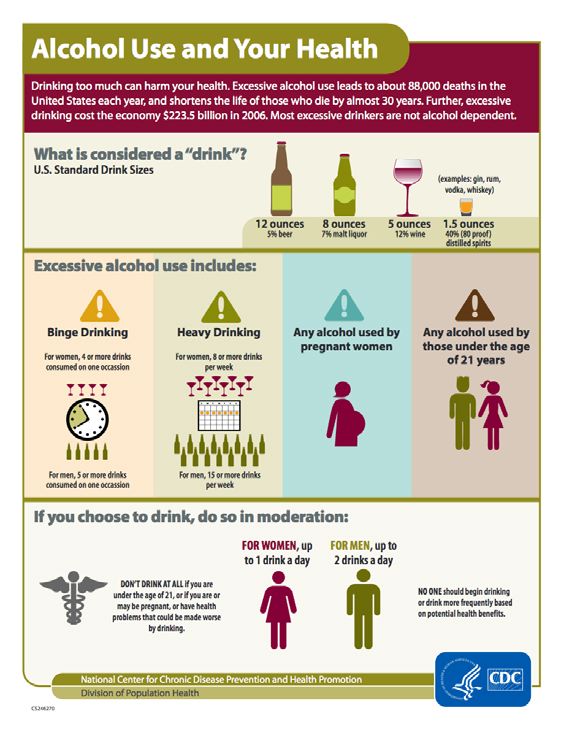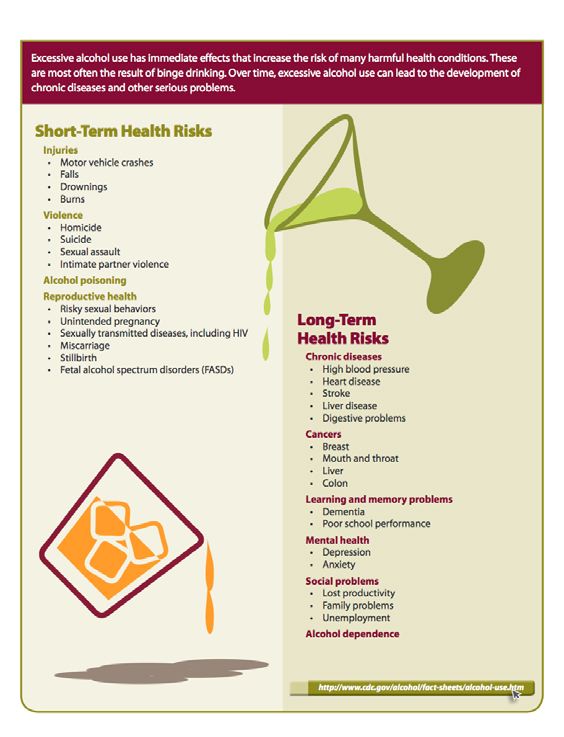Governments & Alcohol Action Groups Have a Loud Voice in 2014
In November 2014, the United States Centers for Disease Control & Prevention (CDC) last updated their fact
sheets on alcohol use and health: www.cdc.gov/alcohol.com. These were published in conjunction with a study
in the CDC Journal titled, “Preventing Chronic Disease,” released in collaboration with the Substance Abuse &
Mental Health Services Administration. This study looked at data on 138,100 United States adults 18 years of
age and older in 2009, 2010 and 2011, participating in the National Survey on Drug Use & Health (NSDUH).
The study reported that nearly 1 in 3 adults is an excessive drinker defined as (1) binge drinking, (2) heavy
drinking, (3) any alcohol use by pregnant women and (4) any alcohol use by those under the legal drinking age
of 21 years. Most excessive drinkers binge drink, usually on multiple occasions, but are not considered
alcoholics while 1 in 30 excessive drinkers are alcohol dependent.
Excessive alcohol use was responsible for 88,000 deaths in the United States each year (3,700 deaths from
alcohol dependence) from 2006-2010 due to short-term health effects including breast cancer, liver and heart
disease, drinking too much over a short period, violence, alcoholic poisoning, and motor vehicle crashes.
The CDC study came in the wake of a proposal by the National Transportation Safety Board to reduce the blood
alcohol limit for drunken driving by one-third. As pointed out by the Wine Curmudgeon blog at
www.winecurmudgeon.com, this study was somewhat alarming to moderate wine drinkers since it equated
drinking the equivalent of one to two glasses of wine daily as heavy or excessive drinking. In addition, the
media alarmed the public unnecessarily. Fueling the fire, The National Institute for Health Care Excellence
(NICE) in the UK called those who drink a couple of large glasses of wine a day “mild alcoholics.”
A CDC Morbidity and Mortality Weekly Report dated January 10, 2014, www.cdc.gov/mmwr, reported that the
government’s concern about excessive alcohol use led the U.S. Preventive Services Task Force (USPSTF)
to recommend that alcohol misuse screening and behavioral counseling for adults (also known as
alcohol screening and brief intervention or ASBI) be instituted in 2004 for adults to address this issue.
Despite these public health efforts, the study found that only one of six U.S. adults ( 1 in 5 current drinkers and
1 in 4 binge drinkers), reported ever discussing alcohol consumption with a physician or other health
professional.
Clearly, alcohol counseling is underutilized by physicians, and increased implementation of ASBI is necessary,
including steps to make discussion and education about alcohol consumption a part of physicians’ routine
medical assessments and care. A 2 minute new video was released in September 2014 hosted by American
Medical Women’s Association President Dr. Farzanna Haffizula that was produced by Mission Critical Health
(MCH). This video, which aired in U.S. physician offices, hospitals and military facilities, encouraged
healthcare professional to talk with patients who drink alcohol about the importance of moderation. The video
provided important science-based information on alcohol and health from the United States Dietary Guidelines
and the CDC. View the video at http://youtu.be/RgV2BZHGHxQ.
The World Health Organization (WHO) issued a report in May 2014 that indicated alcohol was responsible for
3.3 million deaths each year or 5.9% of deaths globally. More than 200 health conditions were described as related to alcohol
and responsible for many of these deaths. The report also noted that Europe had the largest percentage
alcohol consumption of any region of the world. Levels of drinking in Europe, Africa and the Americas have
been steady for the last five years, but Southeast Asia and the Western Pacific have had increased drinking.
The merger of the International Center for Alcohol Policies (ICAP) and the Global Alcohol Producers Group
(GAPG), both funded by nineteen of the world’s leading drinks producers involved, led in 2014 to the creation
of a new alcohol action group, the International Alliance for Responsible Drinking (IARD), It's purpose is to help reduce
harmful drinking and fiercely promote responsible drinking. The Press Release noted, “Continuing and
expanding ICAP’s work, IARD will support implementation of the Beer, Wine and Spirits Producers’
Commitments to Reduce Harmful Drinking (www.producerscommitments.org), and promote responsible
drinking through research, programs, and balanced debate around the world.
Pernod Ricard, a member of IARD, launched a Wise Drinking mobile application in May 2014 that allows users
to monitor their alcohol intake. Users can test their knowledge of responsible drinking through a quiz, keep a
diary of their drinking patterns, and receive notice from the app when driving may be impaired. Visit www.wisedrinking.
com.
Australia’s Foundation for Alcohol Research (FARE), headed by chief executive Michael Thorn, advocated that
clear warnings about short-term and long-term harmful effects of alcohol be mandatory on all alcoholic drink
labels. A voluntary program instituted over two years ago failed to garner compliance presumably because
alcoholic beverage producers feared it woul reduce sales.
The All Parliamentary Group on Alcohol Misuse has also called for health warnings and calorie content on all
drink labels to attempt to reduce alcohol misuse in the U.K.. They reported that 1 in 20 U.K. adults (1.6 million
people) was “dependent” on alcohol. After smoking, alcohol was the second largest preventable killer.
Members of Parliament also proposed to lower the blood alcohol level from 80 mg/100 ml to 50 mg/100 ml -
the same as the lower limits for drivers in France, Spain, Scotland and Northern Ireland, tighter restrictions on
alcoholic beverage ads to the underage group, a phased ban on alcohol company sponsorship of sport teams,
and a minimum price per unit of alcohol to increase the cost of the cheapest drinks in the marketplace. A group
of U.K. doctors supported these changes as a way to reduce excessive alcohol consumption. It appears that
the current drunk driving limit in England will remain unchanged for the time being, but the government has
plans for increasing enforcement.
In February 2015, the Irish government passed a law setting a minimum price for drink sales and alcohol
producers are now required to put health warnings and calorie counts on wine, beer and spirits. Alcohol
advertising will be restricted and marketing alcohol to the underage group will be banned.
Public Health England has publicly advised consumers in the U.K. to refrain from drinking two days in a row (or
at least 2 days a week). In a 92-page paper it was reported that daily drinking contributes to an increased risk
of health issues such as cancer and cirrhosis of the liver. This recommendation was widely criticized as
unrealistic and not a helpful strategy as there is no scientific evidence to support the claim that skipping days is
more healthy. Many believe the Chief Medical Officer would be better served by simply recommending
moderation ( for example, a maximum of one standard drink a day for women and two standard drinks a day
for men).




